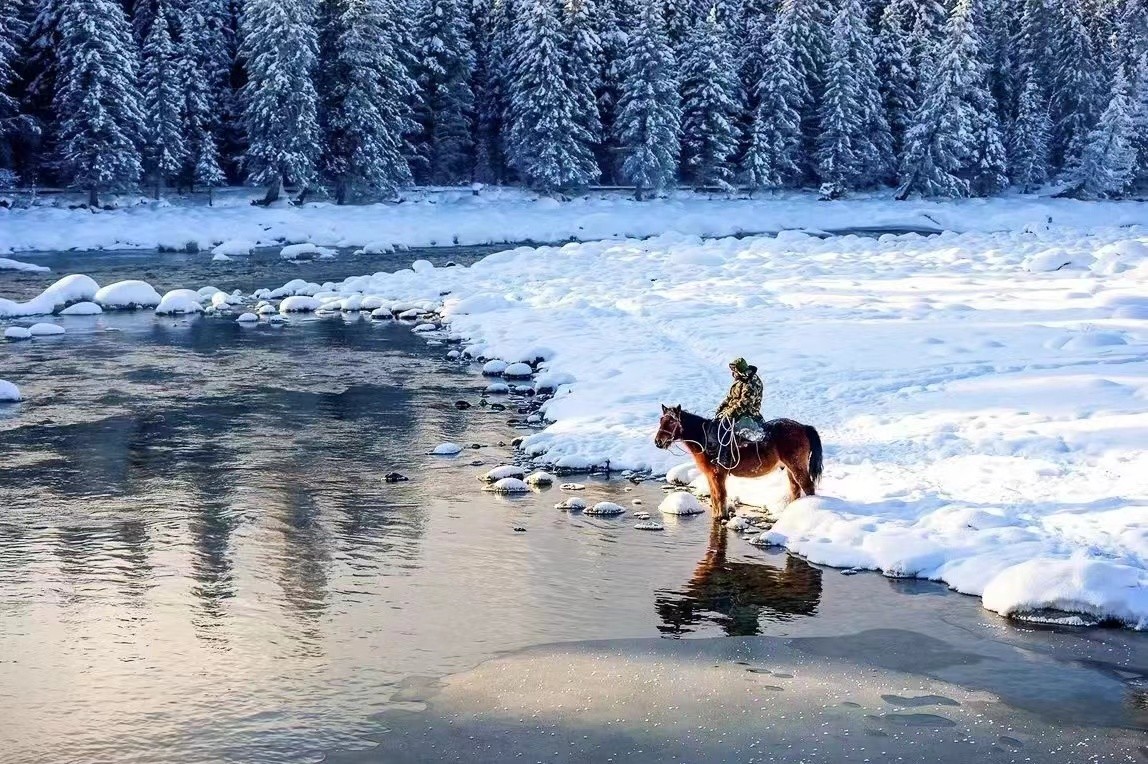When we think caviar, we think of Great Gatsby's high-society socialites in fur shawls and boas. And we aren’t far off. Caviar’s place in popular culture can be attributed to its meteoric rise in cost due to catastrophic shortages.
But now, China has stepped up to the plate and begun to dominate the global caviar industry. China is now the world’s largest caviar producer, with a staggering 14% coming from just one village in Sichuan.
But can companies uphold a reputation of exceptional quality while China floods the market with caviar of varying degrees of quality?
It would appear that, yes, they can... thanks to some truly magnificent (and clean) bodies of water.

Image via Pixabay
At the beginning of the 20th century, the world’s main supply of caviar came from the Caspian Sea, particularly from Russia and Iran, which were renowned for their sturgeon populations. During this time, caviar was abundant and relatively inexpensive.
By the mid-1900s, overfishing and pollution began to severely deplete sturgeon stocks in the Caspian Sea and Black Sea. The Soviet Union controlled much of the caviar market, and caviar became a symbol of luxury and exclusivity in the West.
The collapse of the Soviet Union in the early 1990s led to a lack of regulation, resulting in rampant overfishing. This period saw a dramatic decline in sturgeon populations.
In response, international trade regulations, particularly through the Convention on International Trade in Endangered Species of Wild Fauna and Flora (CITES), were implemented to control and monitor the trade of sturgeon products to prevent extinction.
Facing wild sturgeon populations at critical levels, the late 20th and early 21st centuries saw the rise of sturgeon aquaculture. Countries like China, the United States, and several European nations began investing in sturgeon farming technologies to produce caviar sustainably. This shift not only helped preserve wild sturgeon populations but also democratized caviar consumption, making it more available and slightly less expensive.

Caviar farm in Sichuan Province
The caviar industry today is largely based on aquaculture, with China emerging as a major producer. Innovations in farming practices have improved the sustainability and quality of caviar.
However, the industry still faces challenges, such as maintaining the genetic diversity of farmed sturgeon and combating illegal trade.
The market has also expanded to include vegan and lab-grown alternatives, reflecting growing consumer interest in sustainability and animal welfare. The caviar industry continues to evolve with a focus on sustainable practices and traceability.
Consumers are increasingly aware of the origins and ecological impact of caviar, driving demand for responsibly farmed products.
 Caviar farmers in China
Caviar farmers in China
The turning point for many luxury goods, including caviar, came in the late 20th century as China opened up economically to the rest of the world.
This period saw an influx of Western tastes and luxury products. As China’s economy grew, so did the purchasing power of its middle and upper classes, creating a market for luxury items such as caviar.
In the late 20th and early 21st centuries, China started its own sturgeon farming operations. The Yangtze River and other Chinese water bodies were found to be suitable for sturgeon aquaculture. By the 2000s, China had not only started consuming more caviar but had also become a significant producer, exporting high quality caviar to international markets.
Today, China is one of the world’s largest producers of farmed caviar. The taste for caviar in China is largely driven by the affluent segments of society, and it is often consumed as a symbol of status and luxury. The growth of fine dining culture and international cuisine in China has also played a crucial role in embedding caviar into the culinary landscape.
Thus, China’s taste for caviar has developed significantly over the last few decades, primarily driven by economic growth, global influences, and domestic production capabilities. The trend reflects broader changes in Chinese consumption patterns, with increasing openness to global gourmet foods and luxury experiences.

Beluga caviar. Image via Pixabay
Beluga caviar, derived from the beluga sturgeon (Huso huso), is considered one of the world's most luxurious and expensive food products. However, its importation into the United States is illegal, primarily due to conservation concerns. Here’s an exploration of the reasons and the broader context:
The primary reason for the ban on beluga caviar imports to the U.S. is the endangered status of the beluga sturgeon. This species, which is native to the Caspian Sea, the Black Sea, and the Adriatic Sea, has been critically endangered due to overfishing, habitat loss, and pollution. In an effort to protect the species, the U.S. Fish and Wildlife Service banned the import of beluga caviar in 2005 under the guidelines set by the Convention on International Trade in Endangered Species of Wild Fauna and Flora (CITES).
CITES listings aim to ensure that international trade does not threaten the survival of species in the wild. Beluga sturgeon are listed under Appendix I of CITES, which includes species threatened with extinction and provides the greatest level of protection, including restrictions on commercial trade.
The Caspian Sea has historically been the most significant source of wild sturgeon, including the beluga sturgeon. However, the populations there have been critically depleted due to overfishing, poaching, and environmental degradation. Efforts are ongoing to regulate and reduce fishing to sustainable levels.
Similar to the Caspian Sea, the Black Sea has seen significant declines in sturgeon populations. Overfishing and habitat destruction have severely impacted sturgeon numbers.
Once a prolific source of sturgeon, the Volga River has also experienced significant declines in sturgeon populations due to damming, pollution, and illegal fishing.
North American sturgeon species, such as the Atlantic sturgeon, face pressures from overfishing and habitat loss, though they are typically not used for caviar to the same extent as Eurasian species. Conservation measures are in place to protect these populations.
In comparison to the controversial and expensive beluga caviar, Kaluga sturgeon caviar bypasses the ethical and ecological issues plaguing traditional sources like the Caspian Sea and the Amur River.
Through stringent adherence to international standards and a commitment to quality over price, a handful of major Chinese producers have carved out a niche for themselves in the global market, championing consumer trust through superior and reliable quality.

In the pristine waters of Thousand Island Lake in East China’s Zhejiang province, an environmental haven boasting 573 square kilometers of unique man-made aquatic landscape, Kaluga Queen has pioneered a sustainable revolution in the caviar industry since 1998. Recognized for their innovative practices, the company has filled a significant void in the domestic caviar market, becoming a beacon of quality and sustainability.
Kaluga Queen has been at the forefront of sturgeon cultivation, operating from the scenic expanses of Thousand Island Lake since its inception.
With an annual production capacity of 200 tons, they’ve set a high benchmark in the industry. Xia Yongtao, Director and Deputy General Manager at Kaluga Queen, tells us that the company’s success is rooted in an eco-friendly ethos, employing net cage farming that simulates a natural habitat. This technique not only ensures the healthy growth of the sturgeons but also maintains the ecological integrity of the lake.
Female sturgeon reach their first egg cycle between 6 and 10 years old.
A question that must then be asked is about how the eggs are harvested.
Not all sturgeon caviar is harvested humanely, but given the initial investment of nearly a decade and the potential for sturgeon to live beyond 100, it’s more economical to be ethical.
Kaluga Queen ensures that the sturgeon are not harmed during the harvesting process.
As a comparison, Astrea Caviar employs a different approach to its caviar and has a respectable justification.
Based in Pasadena, California, Astrea began sourcing tailormade caviar from a private batch producer in Yunnan province back in September 2019.
Rather than harvest the caviar on the first egg cycle, Astrea waits for the third cycle which occurs between 12 to 15 years. Co-founder Eve Lin tells us that this added maturity ensures larger, firmer caviar with a developed umami flavor, as well as a 12-15 kg yield of eggs.
The superior flavor is also a result of partially curing within the body of the sturgeon before being harvested, as they are humanely dispatched using the ancient Japanese ikejime technique. Lin assures us that the animal is not wasted and all the delicious lean meat is sold at local markets.
Ikejime involves four steps: brain spiking, where a spike is inserted into the fish's brain to render it brain dead; exsanguination, where blood is drained from cuts at the gill arches and the tail artery; spinal cord destruction, where a metal pith destroys the spinal cord to prevent involuntary muscle movements and lactic acid buildup; and cooling, where the fish is submerged in an ice-water slurry to slow decomposition.
This method minimizes stress and trauma, unlike standard methods where fish suffocate, leading to quality deterioration.
Clearly, ikejime is vastly more labor-intensive and costly, but it remains preferred in high-end culinary settings for its ability to enhance flavor and extend freshness. On a commercial fishing scale, it would be nearly impossible to implement. But this is a specialty luxury product at an artisanal scale so it would almost be a crime not to.
Astrea compares their vision to that of a winery. They set out to create a product that exemplifies the terroir of the natural environment. The farm was chosen for its high elevation, natural mountain spring water and the crisp, clean air that so many travel to Yunnan to enjoy. However, Astrea currently does not distribute within China.

Image via @iChongqing_CIMC/X
The market for Chinese domestic caviar has seen a dynamic shift over the years, with Kaluga Queen at its helm. As Chinese consumers become more acquainted with this luxurious delicacy, caviar is increasingly becoming a staple in both lavish home cooking and in innovative culinary creations at high-end establishments.
Dishes such as caviar roasted duck, caviar roasted suckling pig, and even caviar stinky tofu are gaining popularity, showcasing the versatility of caviar in Chinese cuisine.
Not resting on its laurels, Kaluga Queen has also ventured into hybridization to optimize caviar production. Their 'Sturgeon Dragon No. 1,' a product of collaborative efforts with the Chinese Academy of Fishery Sciences, is especially notable for its large egg diameter and exquisite flavor, making it a favorite among connoisseurs.

Image via Kaluga Queen
Kaluga Queen’s caviar graces the tables of high-end establishments, including 22 French and 5 Michelin three-star restaurants in New York, as well as the first-class cabins of Lufthansa and American Airlines. Moreover, it has been part of prestigious events such as the Oscar dinner, the Obama dinner at the Hangzhou G20 summit, and meetings between Xi Jinping and Donald Trump. Domestically, it has also partnered with Haidilao, China’s renowned hot pot brand, broadening its reach to include uniquely flavored dishes.
[Cover image via Kaluga Queen]





















0 User Comments